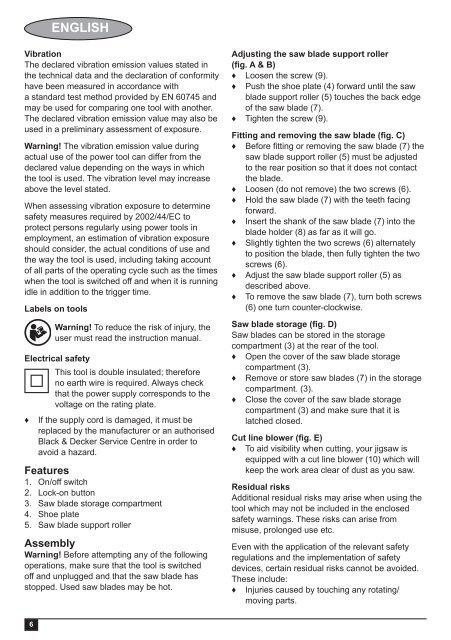BlackandDecker Scie Sauteuse- Ks495 - Type 1 - Instruction Manual (Européen Oriental)
BlackandDecker Scie Sauteuse- Ks495 - Type 1 - Instruction Manual (Européen Oriental)
BlackandDecker Scie Sauteuse- Ks495 - Type 1 - Instruction Manual (Européen Oriental)
Create successful ePaper yourself
Turn your PDF publications into a flip-book with our unique Google optimized e-Paper software.
ENGLISH<br />
Vibration<br />
The declared vibration emission values stated in<br />
the technical data and the declaration of conformity<br />
have be<strong>en</strong> measured in accordance with<br />
a standard test method provided by EN 60745 and<br />
may be used for comparing one tool with another.<br />
The declared vibration emission value may also be<br />
used in a preliminary assessm<strong>en</strong>t of exposure.<br />
Warning! The vibration emission value during<br />
actual use of the power tool can differ from the<br />
declared value dep<strong>en</strong>ding on the ways in which<br />
the tool is used. The vibration level may increase<br />
above the level stated.<br />
Wh<strong>en</strong> assessing vibration exposure to determine<br />
safety measures required by 2002/44/EC to<br />
protect persons regularly using power tools in<br />
employm<strong>en</strong>t, an estimation of vibration exposure<br />
should consider, the actual conditions of use and<br />
the way the tool is used, including taking account<br />
of all parts of the operating cycle such as the times<br />
wh<strong>en</strong> the tool is switched off and wh<strong>en</strong> it is running<br />
idle in addition to the trigger time.<br />
Labels on tools<br />
Warning! To reduce the risk of injury, the<br />
user must read the instruction manual.<br />
Electrical safety<br />
This tool is double insulated; therefore<br />
no earth wire is required. Always check<br />
that the power supply corresponds to the<br />
voltage on the rating plate.<br />
♦ If the supply cord is damaged, it must be<br />
replaced by the manufacturer or an authorised<br />
Black & Decker Service C<strong>en</strong>tre in order to<br />
avoid a hazard.<br />
Features<br />
1. On/off switch<br />
2. Lock-on button<br />
3. Saw blade storage compartm<strong>en</strong>t<br />
4. Shoe plate<br />
5. Saw blade support roller<br />
Assembly<br />
Warning! Before attempting any of the following<br />
operations, make sure that the tool is switched<br />
off and unplugged and that the saw blade has<br />
stopped. Used saw blades may be hot.<br />
Adjusting the saw blade support roller<br />
(fig. A & B)<br />
♦ Loos<strong>en</strong> the screw (9).<br />
♦ Push the shoe plate (4) forward until the saw<br />
blade support roller (5) touches the back edge<br />
of the saw blade (7).<br />
♦ Tight<strong>en</strong> the screw (9).<br />
Fitting and removing the saw blade (fig. C)<br />
♦ Before fi tting or removing the saw blade (7) the<br />
saw blade support roller (5) must be adjusted<br />
to the rear position so that it does not contact<br />
the blade.<br />
♦ Loos<strong>en</strong> (do not remove) the two screws (6).<br />
♦ Hold the saw blade (7) with the teeth facing<br />
forward.<br />
♦ Insert the shank of the saw blade (7) into the<br />
blade holder (8) as far as it will go.<br />
♦ Slightly tight<strong>en</strong> the two screws (6) alternately<br />
to position the blade, th<strong>en</strong> fully tight<strong>en</strong> the two<br />
screws (6).<br />
♦ Adjust the saw blade support roller (5) as<br />
described above.<br />
♦ To remove the saw blade (7), turn both screws<br />
(6) one turn counter-clockwise.<br />
Saw blade storage (fig. D)<br />
Saw blades can be stored in the storage<br />
compartm<strong>en</strong>t (3) at the rear of the tool.<br />
♦ Op<strong>en</strong> the cover of the saw blade storage<br />
compartm<strong>en</strong>t (3).<br />
♦ Remove or store saw blades (7) in the storage<br />
compartm<strong>en</strong>t. (3).<br />
♦ Close the cover of the saw blade storage<br />
compartm<strong>en</strong>t (3) and make sure that it is<br />
latched closed.<br />
Cut line blower (fig. E)<br />
♦ To aid visibility wh<strong>en</strong> cutting, your jigsaw is<br />
equipped with a cut line blower (10) which will<br />
keep the work area clear of dust as you saw.<br />
Residual risks<br />
Additional residual risks may arise wh<strong>en</strong> using the<br />
tool which may not be included in the <strong>en</strong>closed<br />
safety warnings. These risks can arise from<br />
misuse, prolonged use etc.<br />
Ev<strong>en</strong> with the application of the relevant safety<br />
regulations and the implem<strong>en</strong>tation of safety<br />
devices, certain residual risks cannot be avoided.<br />
These include:<br />
♦ Injuries caused by touching any rotating/<br />
moving parts.<br />
6
















